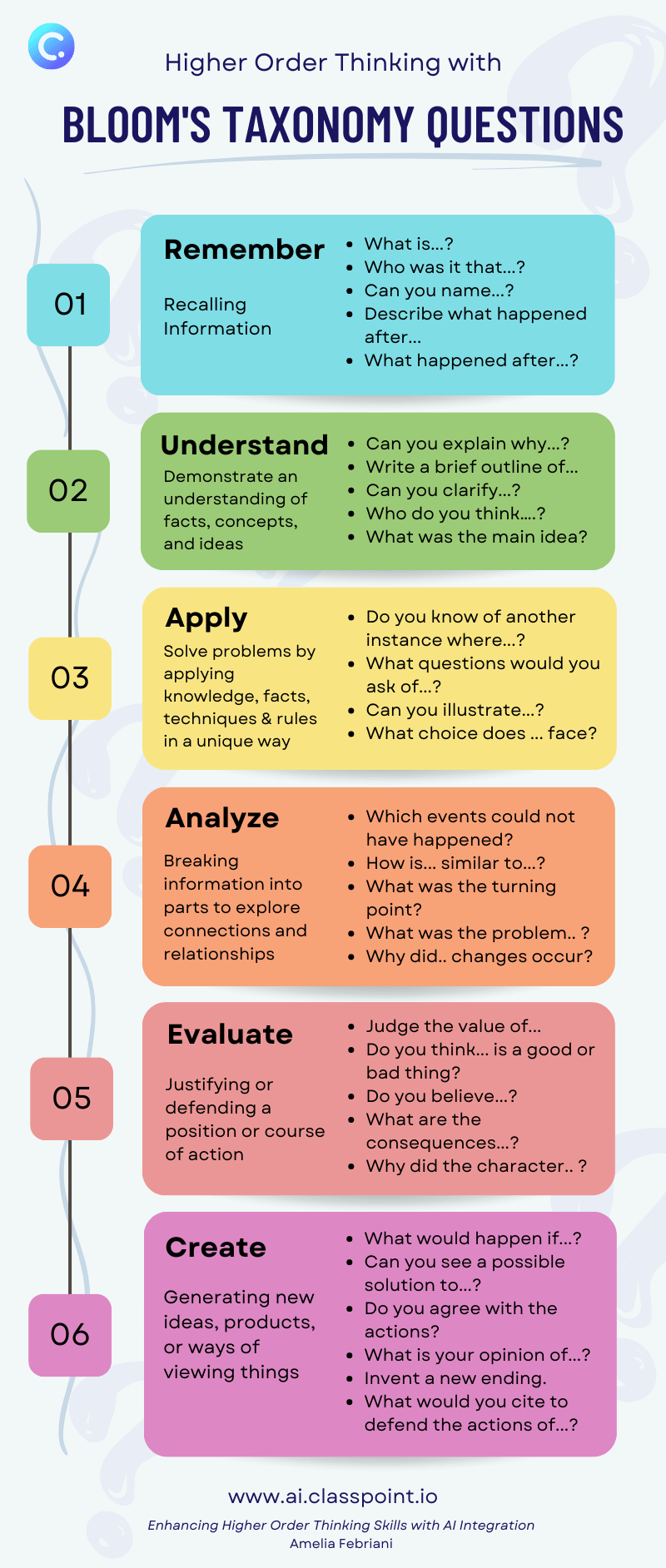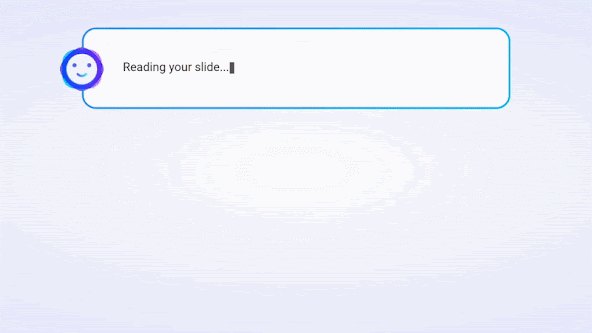The integration of AI (Artificial Intelligence) in all aspects, more specifically in education, has become increasingly notable. From assisting in unit planning, providing feedback, aiding in essay writing, and as learning partners, we see numerous ways to utilize AI in improving classroom instructions.
However, on the other side, the rise of AI highlights an urgency in equipping students with higher-order thinking skills, such as critical and analytical thinking. So, instead of viewing AI as a tool that hinders HOTS, why don’t we think about how we can use AI to enhance HOTS?

Higher Order Thinking
Higher-order thinking involves thinking from the top 3 levels of Bloom’s taxonomy: analysis, the ability to deconstruction information, and/or examine it from differing perspectives; evaluation, the ability to form educated judgments and form relevant critiques; creation, the ability to present learned information in new and unique ways. Higher-level thinking skills require students to use critical thinking. Critical thinking occurs when a learner is able to form their own understanding, connections, and judgments based on learned information.
One of the ways we can promote HOTS in students is by asking questions. Questioning is a tool that teachers use every day in teaching, however, the purpose of questions that promote HOTS, is not to recall facts or information, but to encourage students to think and build a deeper understanding of the material. Such questions push students to dig deeper into the material and help them form a more comprehensive understanding to effectively apply the information in real-world settings.
Higher-level thinking questions are open-ended questions that encourage learners to explore the topic on a deeper level by allowing them to use their knowledge and skills. Open-ended questions are questions that cannot be answered with a simple yes, no, or few-word answer. These types of questions require the person answering to critically think about the information they have learned and develop a cohesive and relevant answer.
Bloom’s Taxonomy Question Types

| Level 1: Remember – Recalling Information | What is…? Who was it that…? Can you name…? Describe what happened after… What happened after…? |
| Level 2: Understand – Demonstrate an understanding of facts, concepts, and ideas | Can you explain why…? Can you write in your own words? Write a brief outline of… Can you clarify…? Who do you think….? What was the main idea? |
| Level 3: Apply – Solve problems by applying knowledge, facts, techniques, and rules in a unique way | Do you know of another instance where…? Demonstrate how certain characters are similar or different. Illustrate how the belief systems and values of the characters are presented in the story. What questions would you ask of…? Can you illustrate…? What choice does … (character) face? |
| Level 4: Analyze – Breaking information into parts to explore connections and relationships | Which events could not have happened? If … happened, what might the ending have been? How is… similar to…? Can you distinguish between…? What was the turning point? What was the problem with…? Why did… changes occur? |
| Level 5: Evaluate – Justifying or defending a position or course of action | Judge the value of… Can you defend the character’s position about…? Do you think… is a good or bad thing? Do you believe…? What are the consequences…? Why did the character choose…? How can you determine the character’s motivation when…? |
| Level 6: Create – Generating new ideas, products, or ways of viewing things | What would happen if…? Can you see a possible solution to…? Do you agree with the actions?…with the outcomes? What is your opinion of…? What do you imagine would have been the outcome if… had made a different choice? Invent a new ending. What would you cite to defend the actions of…? |
Bloom’s Taxonomy Questions for Higher Order Thinking Skills
To create higher-level questions, teachers must possess a deep understanding of the lesson and be able to think about how students can use the information presented to analyze, evaluate, and generate new ideas and perspectives. Additionally, teachers must consider how students can apply this information in a new and different context.
One of the tools that can help teachers crating questions is using action verbs that are associated in each of the thinking orders of Bloom’s taxonomy. These action verbs specify what type of answer a question or objective requires and are often used as the first word in a higher-order question or direction. Examples of higher-order thinking action verbs and how they relate to directions include:
| Bloom’s Taxonomy Level | Action Verbs | Example |
| Apply | Practice, Assign, Complete, Construct, Graph, Draw | “Complete the following sentence: The student forgot (there/their) book.” |
| Analyze | Compare/Contrast, Explain, Separate, Infer, Characterize | “Explain the difference between a protagonist and an antagonist.” |
| Evaluate | Judge, Critique, Defend, Rate, Support, Choose | “Choose which argument is the most logical and defend that choice.” |
| Create | Design, Present, Develop, Generate, Model, Outline | “Design a multi-media presentation that explains the assigned book.” |
It is essential for teachers to be intentional and deliberate in crafting questions that promote HOTS and to create an environment that fosters creativity, collaboration, and critical thinking.
Artificial Intelligence and Higher Order Thinking
“AI (Artificial Intelligence) refers to the development of computer systems that can perform tasks that typically require human intelligence, such as learning, problem-solving, pattern recognition, decision-making, and natural language processing. AI systems use algorithms and mathematical models to analyze data, learn from experience, and make predictions or decisions based on the patterns and insights they derive.”
This paragraph is the answer from one of the AI platforms when we asked it to explain what AI is. Students now can easily obtain answers just like the previous example, create presentations, and get feedback on their writing in a split second. Instead of banning the usage of AI, teachers need to view it as a tool that can enhance instruction Teachers need to start to utilize AI to assist them in teaching, especially to promote higher-order thinking skills in the classroom.
In relation to higher-level questions, AI can help teachers by analyzing the lesson’s content and giving ideas on higher-level questions, analyzing students’ answers and giving personalized feedback, analyzing patterns in student responses, and identifying areas where students may be struggling then generating questions that challenge students to think more deeply and critically.
In conclusion, AI can help us to think critically too. Definitely, some elements are irreplaceable such as cultural context, values, norms, and beliefs of the community of the school, which have to be part of higher-level questions. Yet, by using AI, teachers also now have been forced to think critically about their lesson and ultimately the purpose of the lesson.
Unleashing the Power of ClassPoint AI for Higher Order Thinking Skills

ClassPoint AI revolutionizes classroom engagement and the development of Higher Order Thinking Skills (HOTS) by instantly generating quiz questions from PowerPoint slides. This tool seamlessly blends with your presentations, bringing efficiency and depth to your teaching strategy.
Instant Quiz Generation
With just a few clicks, educators can transform their PowerPoint slides into interactive quizzes. ClassPoint AI analyzes your content and swiftly generates a variety of question types, including Multiple Choice, Short Answer, and Fill in the Blanks. This instantaneity ensures that your teaching flow is uninterrupted, keeping students engaged and on their toes.
Cognitive Complexity
ClassPoint AI isn’t just about asking questions; it’s about asking the right questions. By aligning with Bloom’s Taxonomy Levels, the tool ensures that questions generated challenge students not only to remember but also to analyze, evaluate, and create. This alignment guarantees a balanced cognitive workout, propelling students towards mastering higher-order thinking skills.
Multilingual Support
Inclusivity is at the heart of ClassPoint AI. With its multilingual capabilities, educators and students from diverse linguistic backgrounds can access and benefit from the tool, ensuring that no student is left behind in the journey to develop critical thinking and analytical skills.
Streamlined Integration
Say goodbye to juggling between different platforms and tools. ClassPoint AI integrates seamlessly into your PowerPoint presentations, allowing you to generate and include quiz questions on the fly. This not only saves valuable preparation time but also ensures that your teaching materials are all in one place, ready to go when you are.
A Holistic Learning Platform
ClassPoint AI is part of a larger ecosystem that includes interactive quizzes, gamification, presentation tools, and a community of educators. This integration ensures a comprehensive approach to teaching, providing you with all the resources you need to foster an environment where higher-order thinking skills can thrive.
Reference:
Study.com. (n.d.). Higher Order Thinking Questions: Purpose, Analysis & Examples. Study.com.https://study.com/learn/lesson/higher-order-thinking-questions-purpose-analysis-examples.html
Red Hook Central School District. (n.d.). Bloom’s Taxonomy. Retrieved from https://www.redhookcentralschools.org/cms/lib/NY01000233/Centricity/Domain/3/Bloom.pdf
Looking for an AI tool to promote higher order thinking skills? Look no further than ClassPoint! Integrated into Microsoft PowerPoint, ClassPoint adds an AI question generator that will read your slides, student response questions that you can run without moving to a separate tool, and an array of other handy teaching tools right in PowerPoint. Try ClassPoint out for free!

